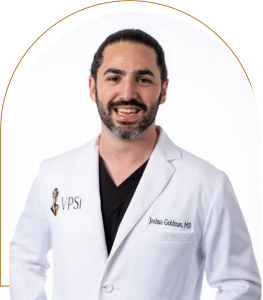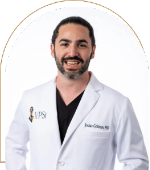Losing sensation in the breast area after a mastectomy can be devastating. This loss not only impacts the emotional connection you have with your body but also leaves you with feelings of grief. It can affect your intimate experiences and relationships, contribute to body image concerns, and influence your overall health. Additionally, long-term numbness may prevent you from detecting changes or abnormalities, underscoring the importance of addressing this issue.
At Vegas Plastic Surgery Institute, Dr. Brosious and Dr. Goldman believe in empowering patients with a sense of wholeness, which is why they specialize in Resensation®, a unique procedure that restores sensation after a mastectomy. They understand that your sense of self does not only rely on how you look externally, but on how you experience touch and feelings on a daily basis.
We’re here to embark with you on a journey to restore breast sensation after a mastectomy. Learn more about Resensation, how it works, when it is typically performed, long-term results, insurance coverage, and more.
What Is Resensation?
There are several reasons why you may have gotten a mastectomy—breast cancer, reducing your risk for certain conditions, gender-affirming care, or for aesthetic purposes. No matter your reasoning, Resensation can help restore your breast sensation if it has been compromised.
Resensation is a highly complex surgical technique that aims to restore sensation in the breasts and nipples using breast neurotization, otherwise known as a repairing of the nerves.
How Resensation Works to Restore Breast Sensation
During a mastectomy, it is common for surgeons to sever nerves in existing breast tissue, leaving the breast area with little to no sensation. This can be highly concerning, as you may feel disconnected from your body.
At Vegas Plastic Surgery Institute, in specific situations, our experienced Resensation surgeon—Dr. Goldman—can skillfully reconnect nerves in the breast area using a nerve allograft, which is a piece of cleaned and prepared nerve tissue that serves as a bridge to fill a gap between the two ends of a damaged nerve. This supports the growth of new nerves, fostering the gradual return of sensation.
The Benefits of Resensation
If you are considering Resensation after mastectomy, the benefits of this intricate procedure go far beyond physical nerve reconstruction. Instead, Resensation offers the opportunity to positively impact your entire well-being.
- Renewed Sensation – Restoring sensation in the breast and nipple area is the main benefit of Resensation. This benefit alone can significantly enhance your overall quality of life.
- Elevated Intimacy – Long-term numbness can take away the joy of being intimate. With Resensation, our doctors can help you experience more pleasure and connection, which may have been compromised after a mastectomy.
- Improved Psychological Well-Being – After mastectomy, many patients often feel a sense of loss or grief. Resensation helps to reestablish a sense of normalcy and connection to your body.
- Better Health Monitoring – Being in tune with your body is a key part of optimizing your overall health. With restored sensation in your breast and nipple area, you can better detect any changes, discomfort, or abnormalities, allowing for early detection and intervention if needed.
- Enhanced Satisfaction – How would it feel to wake up every day with normal sensation and function in your breast and chest area? Resensation can help you live a more satisfactory life by addressing loss of sensation after a mastectomy.
- Innovative Surgical Approach – Resensation is a rather new and innovative surgical technique. At Vegas Plastic Surgery Institute, Dr. Goldman is one of two qualified Resensation surgeons in the entire state of Nevada. You can trust that he will work hard to provide you with the best possible results.
When Is Resensation Performed?
Generally, Resensation is performed as part of the breast reconstruction process following a mastectomy.
Breast Reconstruction Explained
After mastectomy, patients generally have two breast reconstruction options: breast implants or the DIEP (deep inferior epigastric perforator) flap. Which is right for you depends on several factors, including your personal preferences, medical history, and overall treatment plan.
Breast Implants
Breast implants are a widely accepted and effective option for breast reconstruction, as they can offer a natural shape and appearance of the breasts after a mastectomy. Implant options include round or teardrop-shaped silicone implants, which are filled with a silicone gel, or saline implants, which are filled with salt water (saline).
Breast reconstruction with implants may begin with a tissue expander or breast implant, either immediately after your mastectomy (combining the two procedures into one surgery) or later down the road as a delayed procedure.
During your breast reconstruction with implants, your doctor will insert your implants through small incisions, placing the implants either behind or in front of your pectoral muscle. Once the implant is optimally placed (and filled with saline, if choosing a saline implant), your doctor will then close the incisions and prepare you for recovery.
Note that Resensation is not commonly performed with breast implant surgery, as breast implants do not contain natural tissue that has nerve endings.
DIEP Flap
Another breast reconstruction option is the DIEP (deep inferior epigastric perforator) flap, which reconstructs the breasts using your own abdominal tissue. This is an ideal option for those who want to go a more holistic route, as using your own tissue allows for the recreation of a soft, warm breast that looks and feels more natural.
During the DIEP flap procedure, your doctor harvests tissue from your lower abdomen—made up of skin, fat, and blood vessels—while preserving your abdominal muscles. Then, he will transfer the tissue to your chest area to reconstruct your breasts, using microsurgery to meticulously reattach blood vessels to ensure proper blood flow.
Resensation and DIEP flap surgery are often performed during the same procedure, as this is the ideal opportunity to identify and connect healthy nerves to provide optimal breast sensation.
The Long-Term Results of Resensation
Nerve regeneration takes time, so you can expect a gradual improvement in sensation over the course of several months and up to two years after your Resensation surgery. Once your nerves are fully developed, you can expect to benefit from your Resensation results for decades to come.
Does Insurance cover Resensation?
Coverage varies depending on your individual healthcare plan and insurance provider. Generally, insurers require the surgeon to secure pre-authorization in advance of the procedure. For more information on the types of insurance we accept at Vegas Plastic Surgery Institute, contact our practice.
Restore Sensation After a Mastectomy
With Resensation, restoring breast sensation after a mastectomy has never been more achievable. Dr. Goldman, a renowned Resensation surgeon in Las Vegas, NV, is passionate about helping patients look and feel their best through personalized reconstructive surgery. To learn more about getting Resensation at Vegas Plastic Surgery Institute, contact our practice and request a consultation.







